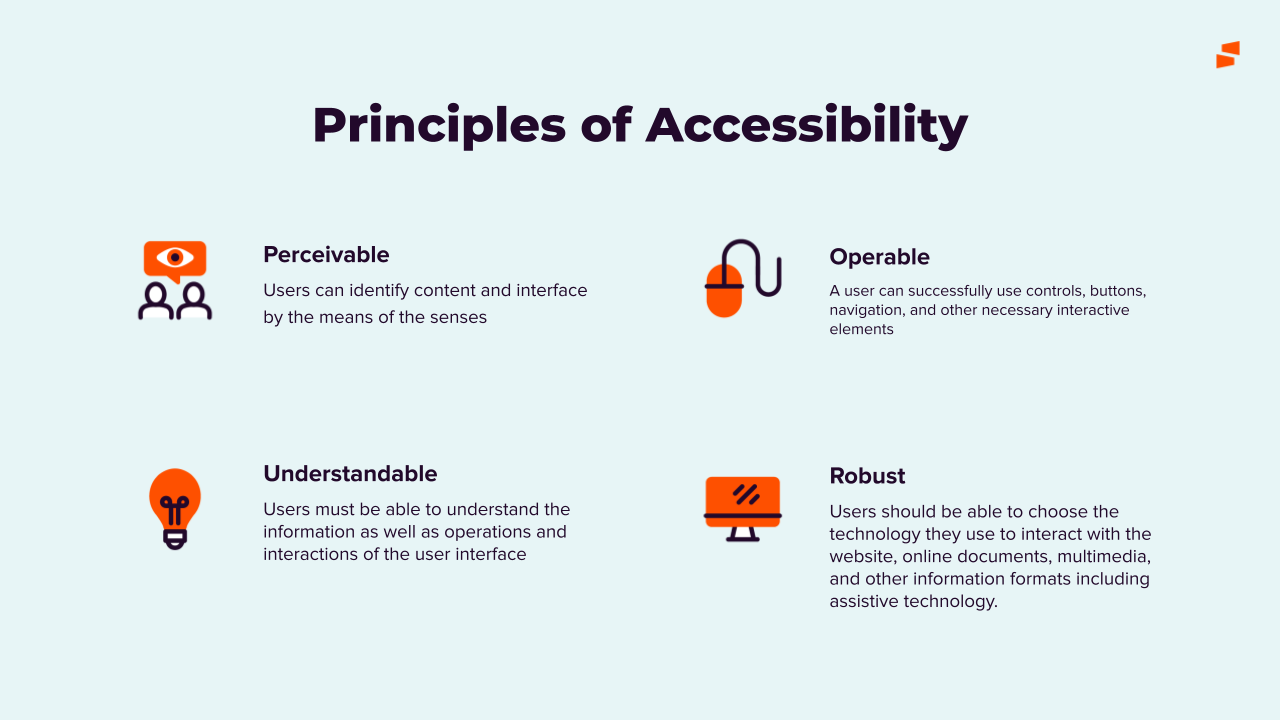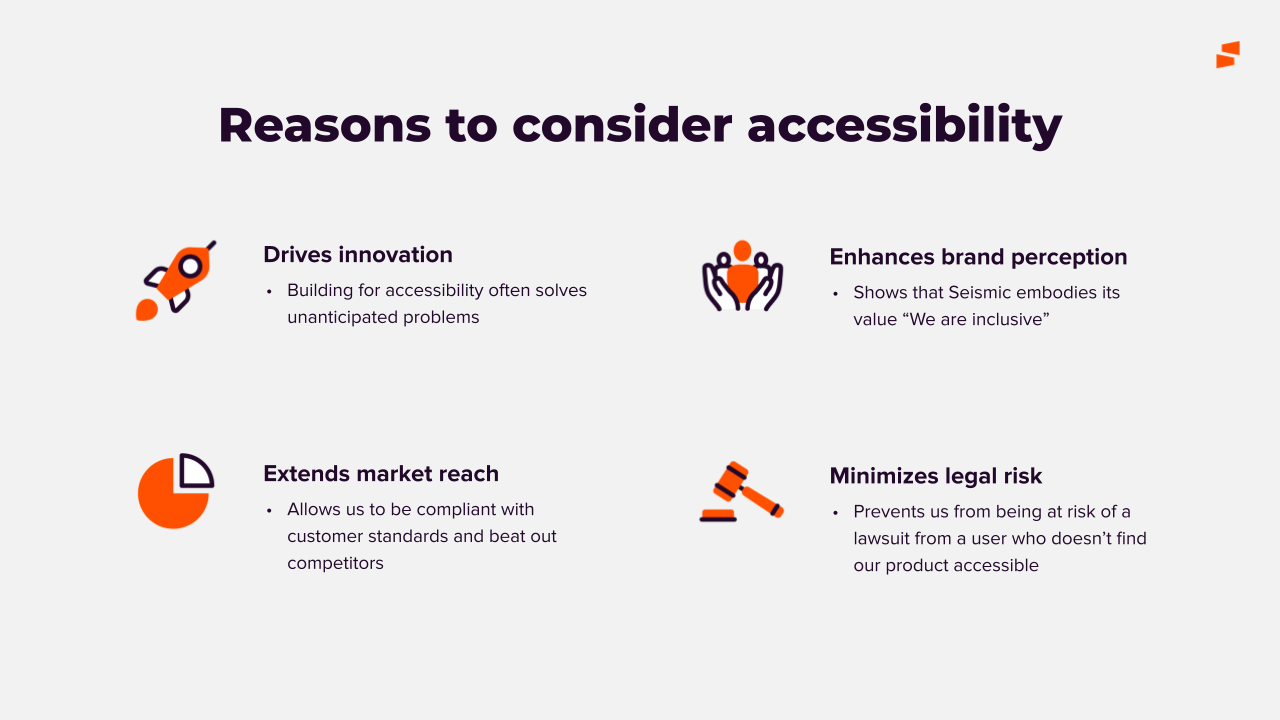Making an Argument for Accessibility
January 2023
Why I started thinking about accessibility
Accessibility in web has always been an area where I felt weak in as a product designer. In October of 2022, I was fortunate enough to be given an education stipend by Seismic to spend on learning new skills for my job. Accessibility has always been top of mind for me because I have read all the Web Content Accessibility Guidelines (WCAG) many times, but have never gotten the chance to understand how to put those guidelines into practice. Seismic, at the time, also had a big initiative to be more accessible and pass WCAG AA standards; but it was a development led effort and often thought of as an after thought. Our process was to design a solution, develop it, and then go back and make enhancements to the accessibility of the software; in my mind, it didn’t make much sense. Why would the developers be the only ones required to make something accessible? Shouldn’t this be a wholistic product practice? These thoughts made me want to become an accessibility expert on my product design team so that I could include accessibility practices earlier in the process.
I started by trying to identify if anyone on my team had experience with accessible design and of the 25+ on my team, accessible design thinking was lacking. We had a design system that was accessible with color use, text size, and labeling; but when using the components in a solution there was still a hole in our approach to accessibility. Additionally, my engineering team would sometimes ask me to review some of their accessibility work, like tab paths and ARIA labels. With all of these things in mind, I knew I wanted to pursue a class in web accessibility.
What I learned
I struggled finding a class that was specific to UX and not just development, but I eventually stumbled upon a class at the UC Berkeley Extension called “Accessibility in UX Design” which was a 10 week course. My professors were well versed in the web accessibility space and one of them even had a lived experience with disability and had to use assistive technologies on a
regular basis.
This course taught a ton about the different types of disabilities people might have and highlighted the struggles of using a website that is not accessible. It also showed the different types of assistive technologies, like screen readers and keyboard only navigation. We even read about about lawsuits filed against companies for not having accessible websites and opinion articles by people with disabilities. Hearing about lived experiences, learning about advocacy for inclusion, and working on a few assignments to identify accessibility pitfalls helped me to empathize with the struggles that people with disabilities have using the web daily.
I found that WCAG was only the tip of the iceberg when it came to making inclusive websites, web accessibility is a design process in and of it self! Like any design thinking project, it’s an attempt to make things most usable for the most amount of people possible, often solved by testing with real users and getting feedback on their experience. Accessible design is no different, its best to get input directly from users with lived experiences of disabilities and test with groups of people to ensure that whatever is designed is usable by all types of users and abilities.
My plan of action
My course taught me how important it was to advocate for accessible design, but I found it difficult to think of how I could re-shape the existing accessibility practices at Seismic. Furthermore, I was one person in a company with 600+ people and surely one course on web accessibility was not enough for me to feel 100% confident in my ability to teach accessible UX practices to my the product team, or even just my product design team members for that matter.
I decided that awareness and advocacy was the best approach in this situation, so I decided to create an argument for accessibility at Seismic in hopes that I could present it to the entire product team and even possibly the whole company.
The argument
Creating a presentation was the best way for my to condense my ideas and visualize specific aspects for my audience. I started my presentation with defining accessibility, the common categories of disabilities, and why it was important. Expanding on those points I outlined why it would be a great business case to have a more accessible product, highlighting that legally companies are requried to have accessible websites and that we could expand out market share to more people. I didn’t want to just focus on the negative things that we as a company don’t do, so I demonstrated the good things we do currently in regards to accessibility, like maintaining an accessible design system. From there I listed a few areas we fall short in, only listing the highest priority issues to ensure that it wasn’t too overbearing for my audience. I demoed myself using assistive technologies with our software and also attempted to navigate things like the Seismic home page with just my keyboard. I recommended a few enhancements to in specific areas like ARIA labels and toast message timing, but in the end I wanted to rally us all around the idea of accessibility thinking at the beginning at the product creation process, not just after implementation.
What’s next
With my completed presentation, I shared it with our Senior VP of Product design and a few other teammates and got the approval I needed to continue my journey of infusing accessible thinking into our process. While I haven’t had the chance to present to the product team, as of February 2023, I am working with our newly hired accessibility program manager on a plan of attack to become a company that cares more about accessibility. In the meantime with my own projects, I am instructing my engineers on tab paths they should be following and labels they should be adding to components for visibility by screen readers. Additionally, I am working with our design system designer to create examples and guidelines for the team to follow.
This journey to buffer my skills in accessible design and thinking has been such an eye opening experience and I continue to learn more about it every day. One major takeaway I have is that accessible design is not a check list or an after thought, but a design process within itself and no one individual is going to be perfect at it. I hope to continue this journey and with the right support behind me I’m confident I can make an impact in the Seismic product process!







